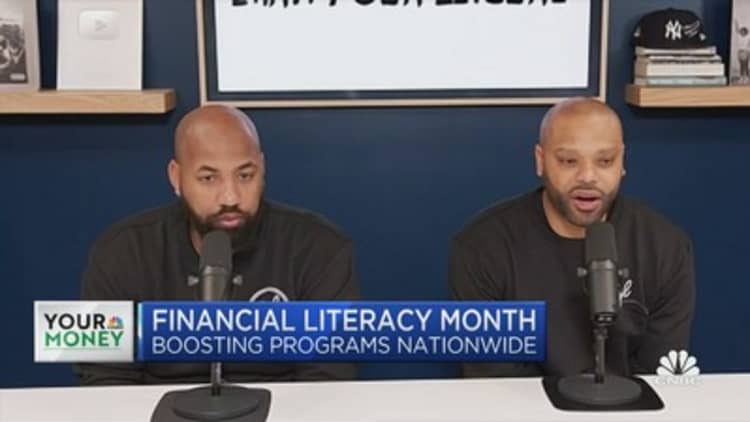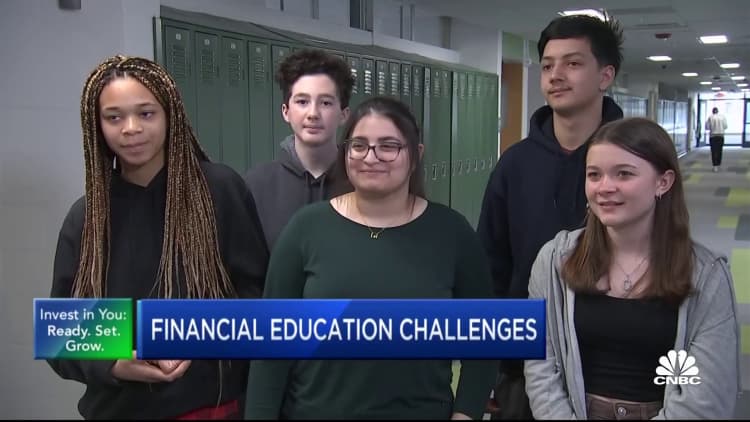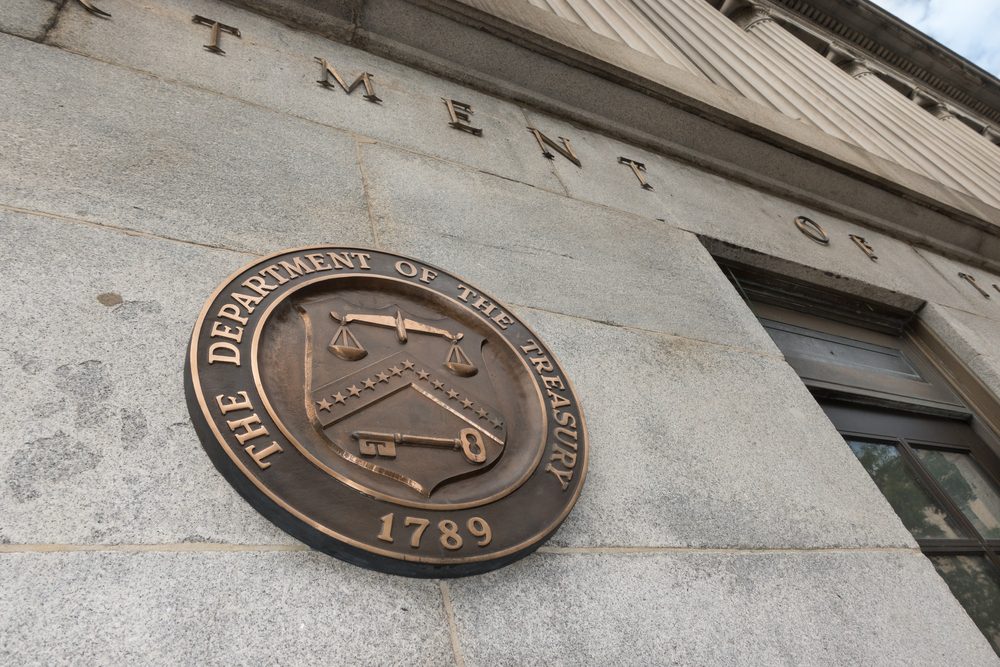Finance
It may take $10 million to achieve ‘financial freedom,’ say ‘Earn Your Leisure’ hosts

Troy Millings, left, and Rashad Bilal, co-creators of Earn Your Leisure.
Source: Tyrell Davis
Rashad Bilal and Troy Millings are among a growing class of financial influencers who want to help people be smarter about money.
The duo — a former financial advisor and a teacher, respectively — launched the podcast “Earn Your Leisure” nearly five years ago with a mission to promote literacy around money and entrepreneurship.
About 1 in 7 people lost more than $10,000 in 2022 due to a lack of financial literacy, according to a study by the National Financial Educators Council.
“I realized there were certain things that weren’t taught inside schools — financial literacy and financial education being one of them,” Millings said of the idea to create Earn Your Leisure.
More from Personal Finance:
As mortgage rates hit 8%, home ‘affordability is incredibly difficult,’ economist says
Student loan borrowers reenter ‘a very messy system’
The 10-year Treasury tops key 5% level: Here’s what that means for you
Today, Earn Your Leisure has expanded to create multiple podcasts, host live events and offer an online educational platform, EYL University. It has 1.4 million Instagram followers and another 1.4 million YouTube subscribers. Its flagship podcast has an average 3 million downloads a month, said Bilal and Millings. It’s also developing a financial literacy curriculum for high schools.
CNBC interviewed the duo — who have been friends since childhood — to talk about personal finance and financial literacy in the U.S.
This interview has been edited and condensed for clarity.
‘Investing is not just for rich and wealthy people’
Greg Iacurci: You told CNBC last year that your “purpose is financial literacy and empowerment.” When it comes to financial literacy, what’s the No. 1 mistake you see people making with their finances?
Rashad Bilal: Not understanding the importance of investing, or [not] knowing how compound interest works.
For a long period of time, investing was something that people looked at more as a luxury, not a necessity, [thinking] if you’re able to invest then you’re in the top 1%, or you have to be wealthy to even consider that.
Investing is not just for rich and wealthy people. It’s for everybody. You can start with smaller balances and dollar-cost average.
Troy Millings: The relationship with money: People don’t understand what to do with it or how to save it. These are simple concepts we’re not taught. When we don’t know what to do, we do what we know, and that’s often spending outside our means. Mistakes are made because nobody is educated.
People may have heard that investing and compound interest are important but might not know why. Can you speak to that?
Bilal: The only way to really achieve financial freedom is if your money is growing without you working for the money. How to achieve that is through investing. One dollar will only be $1 if it’s saved in the bank. But $1 can become $2 if it’s invested.
Most people understand this without even fully realizing that they understand it because they have a retirement plan. The whole point of a retirement plan is investing. You put money into a 401(k), and that money gets invested with the expectation that when you’re 65, 70 years old you’ll have a nest egg you can draw from and live off of in retirement.
The only pathway to not working forever, to having money in abundance, is to find ways to make more money with the money you currently have.
What it takes to achieve financial freedom
Troy Millings, left, and Rashad Bilal, co-creators of Earn Your Leisure.
Source: Greenleaf Multimedia
You mentioned financial freedom. How much money does someone need to be financially free?
Bilal: I think everybody is different. I think it depends on where you live. But I would say, I think you have to be in the eight-figure-net-worth range if you live in suburban or metropolitan areas. I would say around that $10 million figure would provide some level of comfort if other aspects of your life are maintained.
And what is financial freedom?
Millings: I think it’s having enough financial resources to pay for your lifestyle, your living expenses, and also allows you money to invest.
It could differ. It could be in that eight-figure range. Or it could be seven figures. It’s really about having the financial resources to do what you want and invest and create generational wealth. It needs to be something that lasts for generations.

Some people might hear that — seven or eight figures — and think, “How is that possible for me?” Do you think it’s possible for most people?
Bilal: Most people probably aren’t going to make $10 million — I’m just being honest to the question you asked. We have to be honest.
But some people will. This is why we’re big on entrepreneurship, we’re big on investing. You might not be able to accumulate $10 million in your lifetime, but you might be able to accumulate $1 million or $1.5 million. That’s still better than being 70 years old with $20,000 in your bank account.
I think the aspiration towards a certain goal, you might not be able to actually obtain that goal, but if you fall short you’ll still probably be better [off] than you would have been if you had no aspiration and didn’t follow any rules or didn’t try to invest or start a business; you live off what you have. You won’t buy a $1 million home if you only have $1,000 in your bank account. Your life will still be better financially than if you didn’t follow the pathway towards the goal.
Making it ‘cool to be educated’ about money
For the person who’s just starting out investing, how would you suggest they go about it?
Millings: When you’re young, you want to be as aggressive as possible, and when you’re older, you want to get more conservative. Risk mitigation is a huge part of that. We always tell people to start with indexes — an entire index or entire [industry] sector in an exchange-traded fund. That keeps you from having the volatility of watching a stock either appreciate — where you might get some upside — or depreciate, where the risk on the downside is far greater.

In a recent discussion with entrepreneur and musician Sean “Diddy” Combs, you mentioned that when he met you, he said you “make it cool to be educated.” How do you go about that?
Millings: We’re authentically ourselves, so there’s a natural relatability because people see themselves in us. When people talk about finance they try to make it a language that is upspoken to the masses. Our mission was to democratize it, to make it seem like something that can be very relatable and digestible. We show up the way we are, we wear sweatshirts, we wear hoodies. We represent everybody. It doesn’t feel like it’s only for the elite or it’s only for a select crowd.
It’s the same thing in the classroom: A student has to realize this is someone I can learn from and who I want to teach me. Our audience kind of feels that way when they look at us. We’re also very vocal that we’re learning as well. We don’t know everything, and we bring people on [the show] who can educate us.
‘Having money doesn’t alleviate the problems’
For your podcasts, you’ve interviewed several famous and wealthy people — pro athletes, musicians and entertainers, for example. Are there certain things about finance that seem just as confusing for the rich and famous as for the average person?
Bilal: Yeah, I think a lot of people don’t have a full understanding of finance. It doesn’t matter how much money you make. That’s a common misconception.
Having money doesn’t alleviate the problems, it just makes the problems even worse. Understanding money or having a good understanding of money isn’t something that’s correlated with how much money you have.
Financial literacy is something I think gets metastasized on the highest level. Those are the same issues that everybody else has, it’s just everybody else doesn’t have the opportunity to lose $30 million or invest $20 million into a bad investment and then it goes belly up. If given the opportunity they probably would, it’s just they don’t have it. It’s a bigger microscope on celebrities because they’re public figures.
Is that because wealthy people and celebrities have a capacity to overspend more than the average person?
Bilal: I think it’s not so much just a spending situation. That’s a common misconception also, that they go broke because they spend money lavishly. That’s one part of it. But another major part is they’re actually trying to do the right thing, they’re just misinformed.
You see a lot of people make bad decisions when it comes to investing. They’ll invest in things that might be Ponzi schemes, bad real estate deals, they’ll be led down a bad path when it comes to financial advisors or people they trust. They think they’re doing something productive with their money but they actually are losing money because the investments aren’t fully vetted, they don’t fully understand what they’re investing in.
So I think it’s a little more complicated than just spending habits. It all comes back to not having a basic level of understanding and education when it comes to money.
It seems there’s some relatability there for everyday people.
Bilal: For sure. Look at crypto, for example. If you look at [the cryptocurrency] dogecoin, a lot of people made misinformed decisions. They thought they were doing something productive. They didn’t go into it with the intention of losing money. In their brain it was like, ‘This is an opportunity to turn $5,000 into $20,000.’ And they potentially lost all of their money.
It’s the same thing [with celebrities]. It’s just played out on bigger levels.

Finance
Basel Committee Reports on Digitalisation of Finance

- The Basel Committee has published a report on the implications of the digitalisation of finance for banks and supervision.
- The report considers both the benefits and risks of new technologies and the emergence of new technologically enabled suppliers for the provision of banking services.
- It identifies eight implications for banks and supervisors relating to macro-structural elements, specific digitalisation themes, and capacity building and coordination.
The Basel Committee on Banking Supervision published a report that considers the implications of the ongoing digitalisation of finance on banks and supervision. The report builds on the Sound Practices: implications of fintech developments for banks and bank supervisors published in 2018, and takes stock of recent developments in the digitalisation of finance.
The report reviews the use of key innovative technologies across various aspects of the banking value chain, including application programming interfaces, artificial intelligence and machine learning, distributed ledger technology and cloud computing. It also considers the role of new technologically enabled suppliers (eg big techs, fintechs and third-party service providers) and business models.
While digitalisation can benefit both banks and their customers, it can also create new vulnerabilities and amplify existing risks. These can include greater strategic and reputational risks, a larger scope of factors that could test banks’ operational risk and resilience, and potential system-wide risks due to increased interconnections. Banks are implementing various strategies and practices to mitigate these risks, but effective governance and risk management processes remain fundamental.
Digitalisation raises regulatory and supervisory implications for both banks and supervisors. These include:
- monitoring evolving risks and adopting a responsible approach to innovation;
- safeguarding data and implementing robust risk management processes; and
- securing the necessary resources, staff and capabilities to assess and mitigate risks from new technologies and business models.
The Committee will continue to monitor developments related to the digitalisation of finance. Where necessary, it will consider whether additional standards or guidance are needed to mitigate risks and vulnerabilities.
Source: BIS
Finance
Treasury Department to Use ‘Automation and Innovation’ to Fight Illicit Finance

The Department of the Treasury has outlined the priorities it will pursue this year to step up the fight against illicit finance.
The agency aims to increase transparency, leverage partnerships and support responsible technological innovation, it said in a Thursday (May 16) press release announcing the publication of its “2024 National Strategy for Combating Terrorist and Other Illicit Financing.”
One of the Department’s priorities for the year is closing legal and regulatory gaps in the country’s anti-money laundering and combating the financing of terrorism (AML/CFT) framework, according to the release. It aims to do so by operationalizing the beneficial ownership information registry; finalizing rules covering the residential real estate and investment advisor sectors; and assessing the vulnerability of other sectors.
A second priority is promoting a more effective and risk-focused AML/CFT regulatory and supervisory framework for financial institutions, the release said. The Department will work to do so by providing clear compliance guidance, sharing information and providing resources for supervision and enforcement.
The Department also aims to enhance the operational effectiveness of law enforcement, other U.S. government agencies and international partnerships to combat illicit finance, per the release.
The fourth priority announced in the press release is realizing “the benefits of responsible technological innovation” by developing new payments technology, supporting the use of new mechanisms for compliance, and using automation and innovation to find new ways to fight illicit finance, the release said.
“In this critical moment for our national and economic security, we need to continue to close the pathways that illicit actors seek to exploit for their schemes,” Brian E. Nelson, Under Secretary of the Treasury for terrorism and financial intelligence, said in the release. “We recognize the threat illicit financial activity represents to our national security, economic prosperity, and our democratic values, and are focused on addressing both the challenges of today and emerging concerns.”
These recommendations are meant to address key risks the Department of the Treasury identified in February in its “2024 National Money Laundering, Terrorist Financing, and Proliferation Financing Risk Assessments.”
In another recent move, the Treasury Department said in April that it wants more tools to curb terror financing.
In testimony released ahead of an April 9 appearance before the Senate Banking Committee, Deputy Secretary Wally Adeyemo said terrorist groups and state actors continually “seek new ways to move their resources in light of the actions we are taking to cut them off from accessing the traditional financial system.”
For all PYMNTS B2B coverage, subscribe to the daily B2B Newsletter.
Finance
The Great Financial Crisis kick started the private credit boom, but SVB was its true 'watershed' moment, Sixth Street co-president says

The Global Financial Crisis threw millions of Americans out of their homes and jobs, upending the entire economy. But for the private credit industry, it was actually an awakening of sorts.
Over the past few decades, U.S. banks’ problems have signaled opportunity for the private credit market, and that’s particularly true of the Global Financial Crisis and the collapse of Silicon Valley Bank last March. When banks have issues, U.S. businesses’ desire for capital rarely wanes dramatically, and that leaves room for alternate lenders.
At the Fortune Future of Finance conference on Thursday, Joshua Easterly, co-CIO and co-president of the global investment firm Sixth Street, explained how he was working at Goldman Sachs after the Global Financial Crisis in 2009, running a team that did public and private market transactions in distressed debt and special situations, when he came to the realization that the lending industry had changed forever.
“It was the intended consequence, not the unintended consequence of regulations after the Crisis,” he said of the private credit boom. “Policymakers…wanted to figure out how to diffuse risk away from the taxpayer, but you couldn’t crush the economy by reducing credit, and so private credit history grew.”
Easterly argued that the private credit industry has a “better model” than the banking industry when it comes to lending risk, because it holds more capital for loans on balance sheets. And that made him come to a startling realization in 2009. “Huh? I think I need to go find a new job,” he recalled saying to a colleague. “So [the move to private credit] was a little bit about necessity.”
Carey Lathrop, partner and chief operating officer of credit at Apollo Global Management, echoed Easterly’s comments, noting that when he started in the private credit industry “it was clear how hard it was to get things done that made economic sense” in public markets after the GFC.
The rise of private credit since 2008 has been historic, to say the least. Before the crisis, there was under $400 billion in total assets and committed capital in private credit. In 2023, that number jumped to $2.1 trillion, according to the International Monetary Fund. But it wasn’t just the Crisis that spurred the private credit boom. After the collapse of several regional banks in March 2023, headlined by the tech startup focused Silicon Valley Bank, businesses nationwide once again turned to private credit amid a liquidity crunch.
While SVB struggled after rapidly rising interest rates devalued its long-dated bonds, leading to a run on deposits from its list of influential and well-connected clientele, the manner in which private credit operates can lead to more stability in trying times.
Apollo’s Lathrop explained that banks like SVB “had this mismatch with a lot of long-term assets with assets with short term liabilities” that led to unrealized loan losses on their books as rates soared. But private credit doesn’t have this same issue. “We don’t run the [private credit] business that way,” he noted. “We were much more match funded.”
To his point, unlike banks, which fund a majority of their lending through customer deposits (and often uninsured deposits), private credit funds tend to use money from wealthy investors and institutions to make loans, leaving them less exposed to rising interest rates.
Sixth Street’s Easterly said the SVB drama essentially showed “the robustness” of the private credit] business model, leading a raft of new clientele. “I think it was a watershed moment for the value of the asset class.”
-

 Politics1 week ago
Politics1 week ago'You need to stop': Gov. Noem lashes out during heated interview over book anecdote about killing dog
-

 News1 week ago
News1 week agoMan, 75, confesses to killing wife in hospital because he couldn’t afford her care, court documents say
-

 Politics1 week ago
Politics1 week agoRFK Jr said a worm ate part of his brain and died in his head
-

 World1 week ago
World1 week agoPentagon chief confirms US pause on weapons shipment to Israel
-

 Politics1 week ago
Politics1 week agoHere's what GOP rebels want from Johnson amid threats to oust him from speakership
-

 World1 week ago
World1 week agoPro-Palestine protests: How some universities reached deals with students
-

 World1 week ago
World1 week agoConvicted MEP's expense claims must be published: EU court
-

 Politics1 week ago
Politics1 week agoCalifornia Gov Gavin Newsom roasted over video promoting state's ‘record’ tourism: ‘Smoke and mirrors’





















